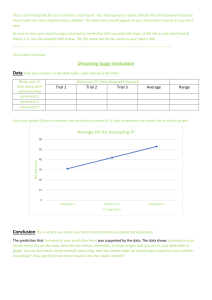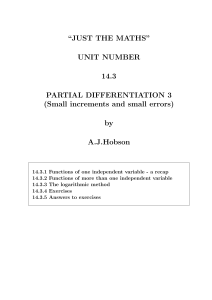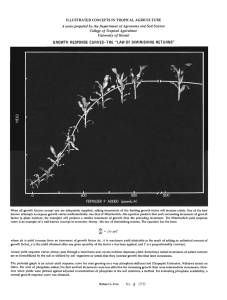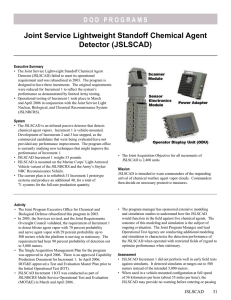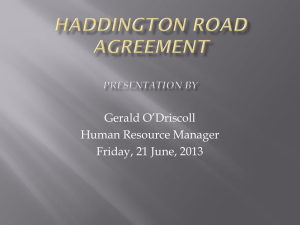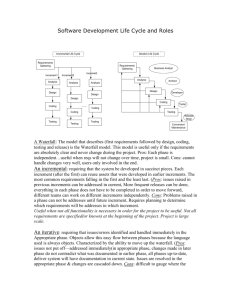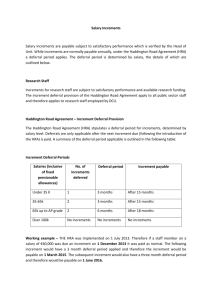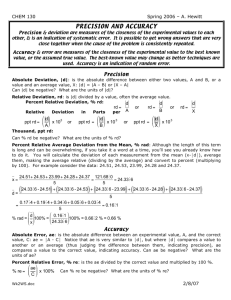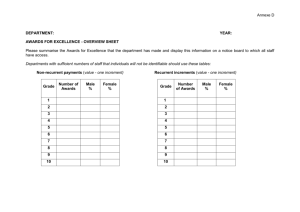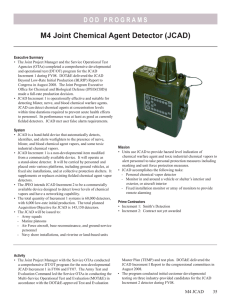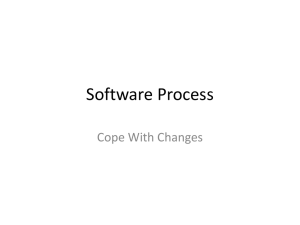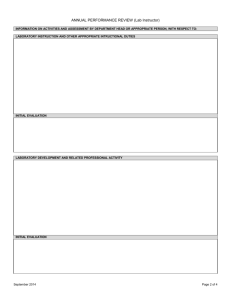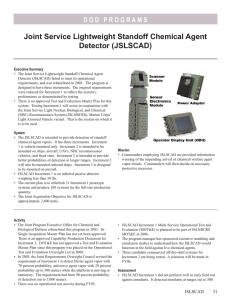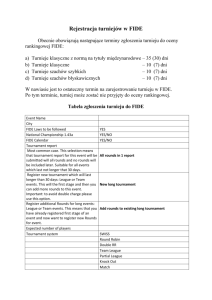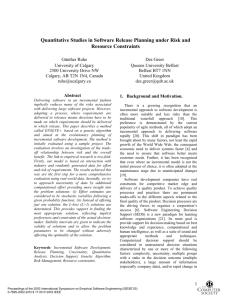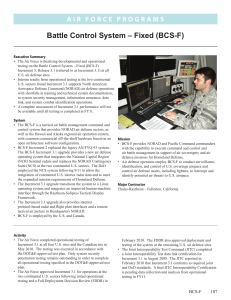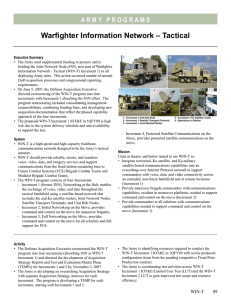unit 11.6 - differentiation applications 6
advertisement
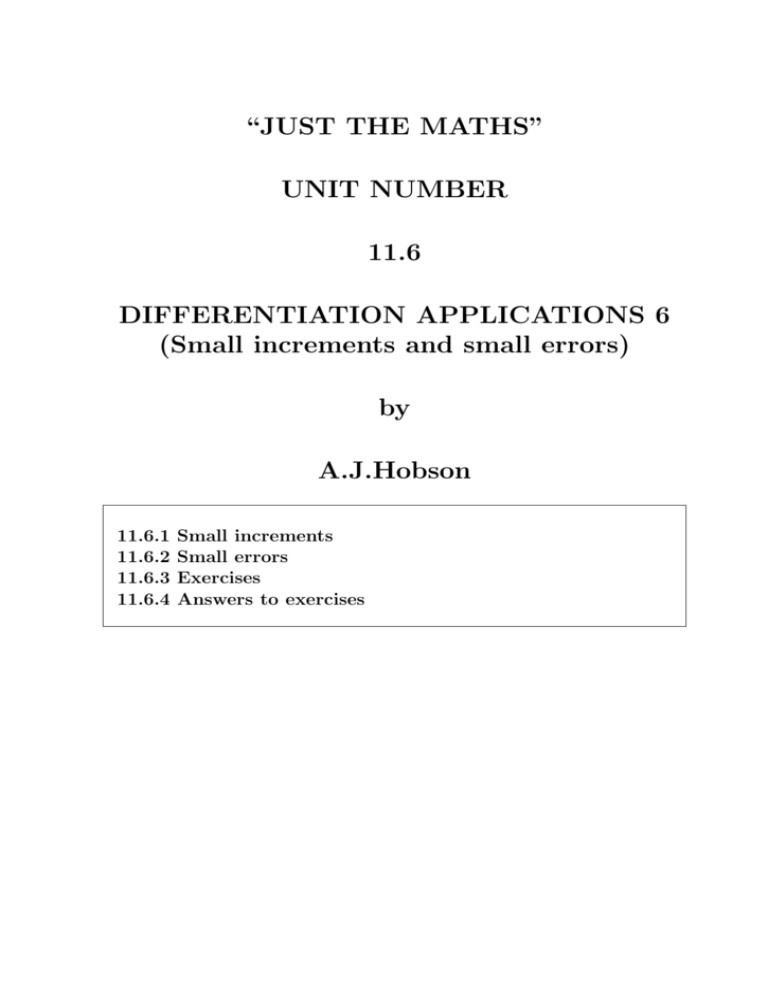
“JUST THE MATHS” UNIT NUMBER 11.6 DIFFERENTIATION APPLICATIONS 6 (Small increments and small errors) by A.J.Hobson 11.6.1 11.6.2 11.6.3 11.6.4 Small increments Small errors Exercises Answers to exercises UNIT 11.6 - DIFFERENTIATION APPLICATIONS 6 SMALL INCREMENTS AND SMALL ERRORS 11.6.1 SMALL INCREMENTS Given that a dependent variable, y, and an independent variable, x are related by means of the formula y = f (x), suppose that x is subject to a small “increment”, δx, In the present context we use the term “increment” to mean that δx is positive when x is increased, but negative when x is decreased. The exact value of the corresponding increment, δy, in y is given by δy = f (x + δx) − f (x), but this can often be a cumbersome expression to evaluate. However, since δx is small, we may recall, from the definition of a derivative (Unit 10.2), that f (x + δx) − f (x) dy ' . δx dx That is, δy dy ' ; δx dx and we may conclude that δy ' dy δx. dx For a diagramatic approach to this approximation for the increment in y, let us consider the graph of y against x in the neighbourhood of the two points P(x, y) and Q(x + δx, y + δy) on the curve whose equation is y = f (x). 1 y Q(x + δx, y + δy) 6 S P(x, y) R(x + δx, y) δx -x O In the diagram, PR = δx, QR = δy and the gradient of the line PS is given by the value of dy at P. dx Taking SR as an approximation to QR, we obtain " SR dy = PR dx # . P In other words, " SR dy = δx dx # . P Hence, " dy δy ' dx # δx, P which is the same result as before. Notes: dy (i) The quantity dx δx is known as the “total differential of y” (or simply the “differential of y”). It provides an approximation (including the appropriate sign) for the increment, δy, in y subject to an increment of δx in x. 2 (ii) It is important not to use the word “differential” when referring to a “derivative”. Rather, the correct alternative to “derivative” is “differential coefficient”. (iii) A more rigorous approach to the calculation of δy is to use the result known as “Taylor’s Theorem” (see Unit 11.5) which, in this context, would give the formula f 00 (x) f 000 (x) (δx)2 + (δx)3 + . . . . 2! 3! f (x + δx) = f (x) + f 0 (x)δx + Hence, if δx is small enough for powers of two and above to be neglected, then f (x + δx) − f (x) ' f 0 (x)δx to the first order of approximation. EXAMPLES 1. If a square has side xcms., determine both the exact and the approximate values of the increment in the area Acms2 . when x is increased by δx. Solution (a) Exact Method δx x δx x The area is given by the formula A = x2 . If x increases by δx, then the increase, δA, in A may be obtained from the formula 3 A + δA = (x + δx)2 = x2 + 2xδx + (δx)2 . That is, δA = 2xδx + (δx)2 . (b) Approximate Method Here, we use dA = 2x dx to give δA ' 2xδx; and we observe from the diagram that the two results differ only by the area of the small square, with side δx. 2. If y = xe−x , calculate, approximately, the change in y when x increases from 5 to 5.03. Solution We have dy = e−x (1 − x), dx so that δy ' e−x (1 − x)δx, where x = 5 and δx = 0.3. Hence, δy ' e−5 .(1 − 5).(0.3) ' −0.00809, showing a decrease of 0.00809 in y. We may compare this with the exact value which is given by δy = 5.3e−5.3 − 5e−5 ' −0.00723 4 3. If y = xe−x , determine, in terms of x, the percentage change in y when x is increased by 2%. Solution Once again, we have δy = e−x (1 − x)δx; but, this time, δx = 0.02x, so that δy = e−x (1 − x) × 0.02x. The percentage change in y is given by δy e−x (1 − x) × 0.02x × 100 = × 100 = 2(1 − x). y xe−x That is, y increases by 2(1 − x)%, which will be positive when x < 1 and negative when x > 1. Note: It is usually more meaningful to discuss increments in the form of a percentage, since this gives a better idea of how much a variable has changed in porportion to its original value. 11.6.2 SMALL ERRORS In the functional relationship y = f (x), let us suppose that x is known to be subject to an error in measurement; then we consider what error will be likely in the calculated value of y. In particular, suppose x is known to be too large by a small amount, δx, in which case the correct value of x could be obtained if we decreased it by δx; or, what amounts to the same thing, if we increased it by −δx. dy Correspondingly, the value of y will increase by approximately − dx δx; that is, y will dy decrease by approximately dx δx. 5 Summary We conclude that, if x is too large by an amount δx, then y is too large by approximately dy dy δx; though, ofcourse, if dx itself is negative, y will be too small when x is too large and dx vice versa. EXAMPLES 1. If y = x2 sin x, calculate, approximately, the error in y when x is measured as 3, but this measurement is subsequently discovered to be too large by 0.06. Solution We have dy = x2 cos x + 2x sin x dx and, hence, δy ' (x2 cos x + 2x sin x)δx, where x = 3 and δx = 0.06. The error in y is therefore given approximately by δy ' (32 cos 3 + 6 sin 3) × 0.06 ' −0.4838 That is, y is too small by approximately 0.4838. 2. If y= x , 1+x determine approximately, in terms of x, the percentage error in y when x is subject to an error of 5%. Solution We have dy 1+x−x 1 = = , 2 dx (1 + x) (1 + x)2 so that 6 δy ' 1 δx, (1 + x)2 where δx = 0.05x. The percentage error in y is thus given by δy 1 x+1 5 × 100 ' × 0.05x × × 100 = . 2 y (1 + x) x 1+x Hence, y is too large by approximately negative when x < −1. 5 % 1+x which will be positive when x > −1 and 11.6.3 EXERCISES 1. If y= e2x , x calculate, approximately, the change in y when x is increased from 1 to 1.0025. State your answer correct to three significant figures. 2. If y = (2x + 1)5 , determine approximately, in terms of x, the percentage change in y when x increases by 0.1%. 3. If y = x3 ln x, calculate approximately, correct to the nearest integer, the error in y when x is measured as 4, but this measurement is subsequently discovered to be too small by 0.12. 4. If y = cos(3x2 + 2), determine approximately, in terms of x, the percentage error in y if x is too large by 2%. You may assume that 3x2 + 2 lies between π and 7 3π . 2 11.6.4 ANSWERS TO EXERCISES 1. y increases by approximately 0.0185. 2. y increases by approximately x % (2x+1) 3. y is too small by approximately 10. 4. y is too small by approximately −12x2 tan(3x2 + 2). 8
